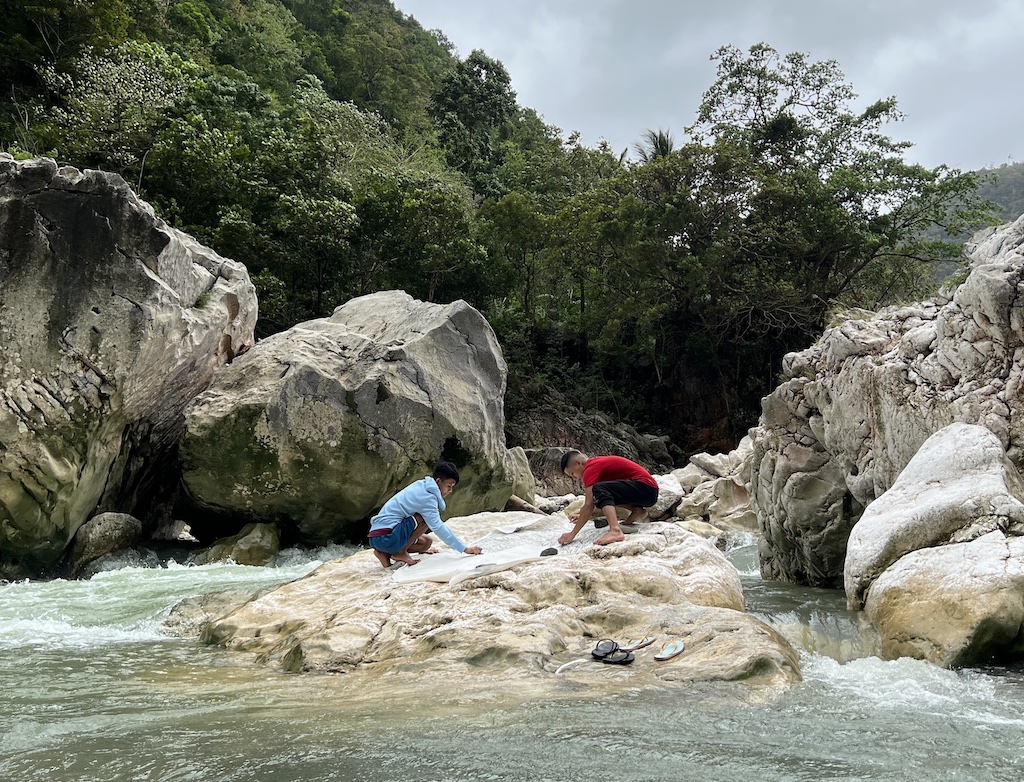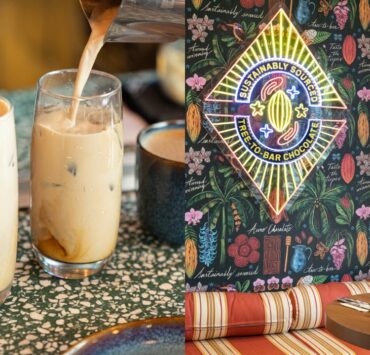The construction of Kaliwa Dam, formally known as the New Centennial Water Source-Kaliwa Dam Project (NCWS KDP), continues despite mounting concerns about the P12.2-billion dam’s environmental impact, China-backed funding, and indigenous peoples’ loss of habitat.
Just last month, more than 300 members of the indigenous community from the Sierra Madre along with multisectoral organizations began their 150-kilometer protest march from General Nakar, Quezon Province to Malacañang. The crowd represents over 200 families which will be affected by the construction of the dam that is expected to solve Metro Manila’s water shortage issue. (This is counter to the Manila Waterworks and Sewerage Systems’ underestimation that only 15 families will be affected by the construction.) This is only a fraction of what nature conservation organization Haribon estimates to be over 5,000 Dumagat-Remontados indigenous people who live in and depend on that ecosystem.
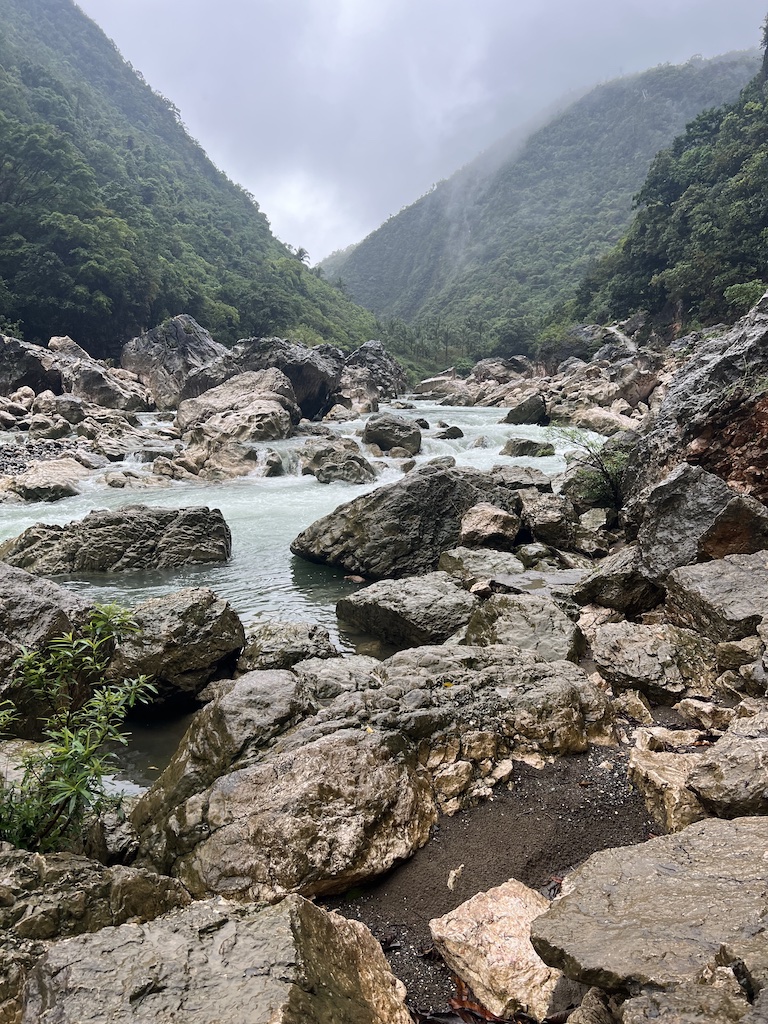
While the tangible impact of the 60-meter-high reservoir that will cover 291 hectares of the Kaliwa Watershed Forest Reserve and Dumagat-Remontado ancestral domains in the Quezon and Rizal provinces is well documented, advocates also worry about its cultural impact on indigenous peoples whose traditions, ways of living, and history has long revolved around their lands.
Tracing the rocks of Tinipak River
Artist and community worker Vien Valencia, founder of community-based artistic research and educational laboratory Nomad Projects, fear the destruction wrought by building the dam will effectively erase indigenous nature-based collective memories.
By recording these rocks through frottage, we create a lasting record of something that will no longer exist in the future.

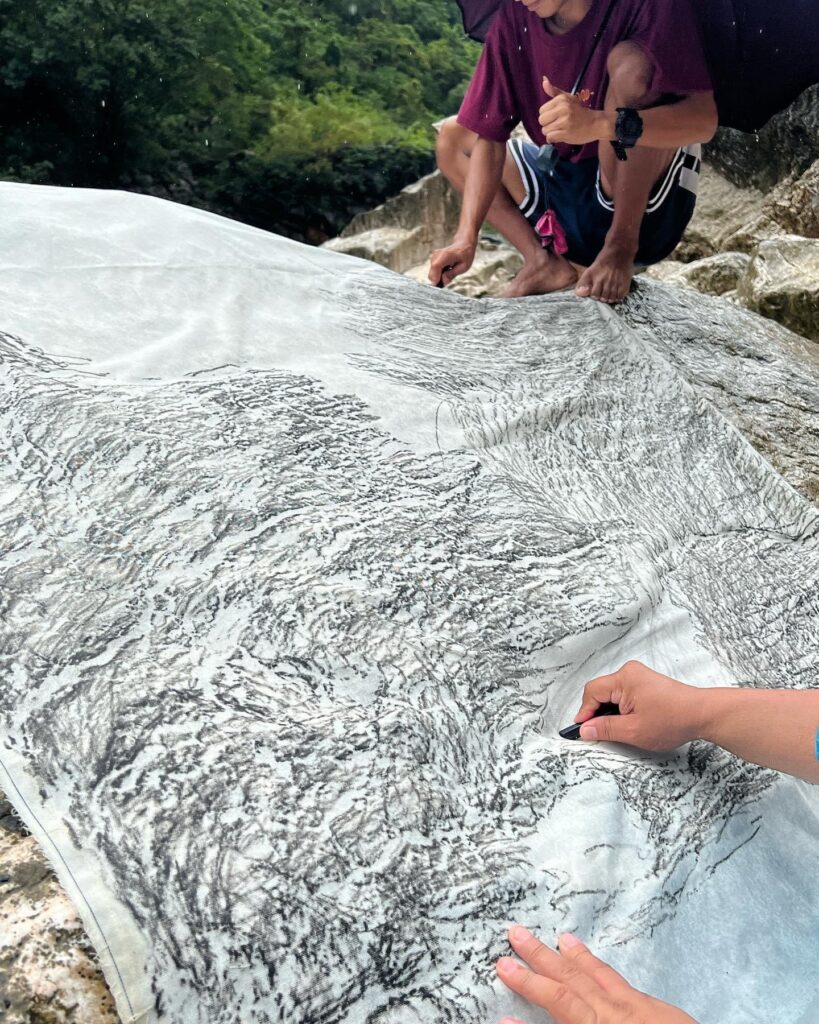
One of the natural features in danger of being wiped out by Kaliwa Dam is the Tinipak River in Tanay, Rizal, famed for its limestone formations. “Tinipak means ‘chipped off’ or ‘chopped up’ (tipak-tipak), referring to the rock formations,” Valencia told Nolisoli.ph in an email. “It’s very important sa identity ng Tinipak River. The locals told us, lahat ito will be submerged once Kaliwa Dam is finished… hanggang pictures na lang.”
He recalled a recent visit to the community in Daraitan, Tanay, Rizal, where a local told him that already individuals had tried to ship the rocks to Manila because of their exceptional quality as construction material.
The race to save the material memory of the river—the rocks—inspired Valencia’s Nomad Projects to document each of them by way of tracing their surfaces on fabric.

“By recording these rocks through frottage, we create a lasting record of something that will no longer exist in the future. This documentation could serve as a reference for future generations who may want to study or at least appreciate these rocks. Its memory will live on, even if the physical objects themselves are no longer present,” he said.
Tracing is a simple form of art that everyone can participate in, he said, adding that it was also during this activity that they were able to have meaningful conversations with the community. “Kaya we named the project ‘your age, my age, and the age of the river.’ We feel that the project needs to be centered sa narrative that the river was already here before we were even born. And it’s about a group of locals and artists from diverse generations gathering into a conversation.”
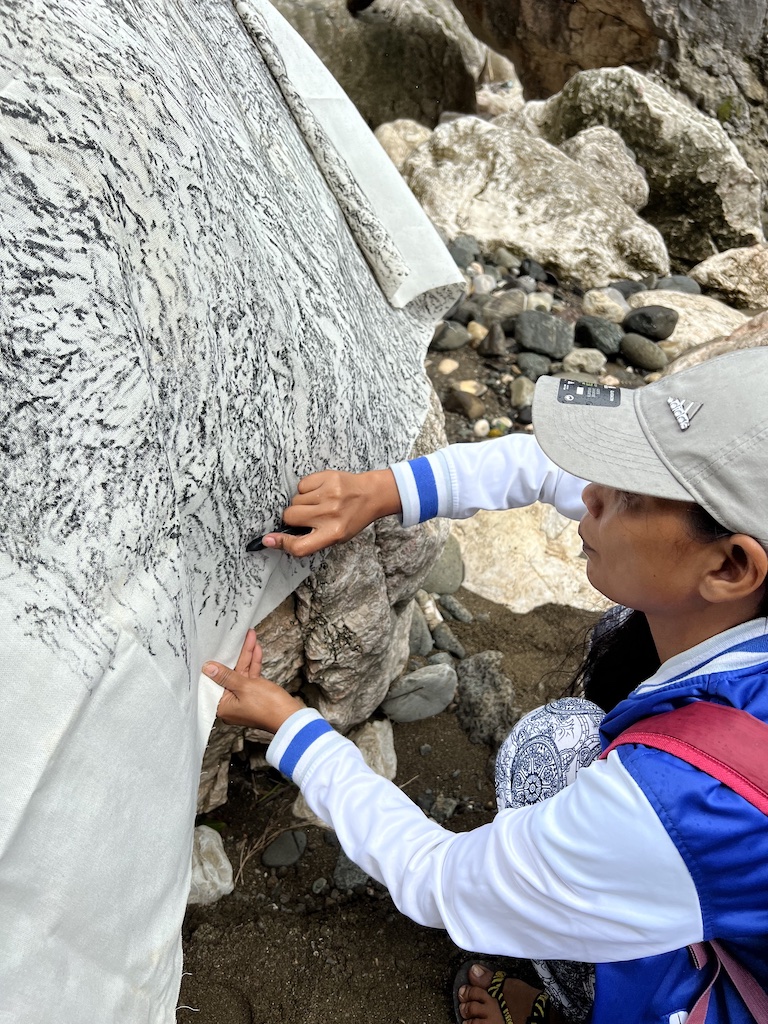
Elders and youth, mothers, and children alike found temporary solace in creating imprints of the rocks with canvas and crayons as they recall the experience of their fellow Dumagat-Remontado who just came back from marching to Malacañang. “Hindi naman din sila pinansin pagdating doon,” one of them said. Another local added as they traced—Valencia remembered with a noticeable frown—“Wala naman na kaming magagawa kundi sumunod, ganito lang kami.”
Other than serving as a vessel for memory, Nomad Project hopes to curate the pieces into a touring exhibition in hopes of reaching more people and sharing the indigenous people’s experience not just of displacement but of a time before disruption. “We really hope we can get the support of academic institutions and artist-run spaces in the country to hear this project, and get more people into the conversation.”
Community and creation

Valencia himself grew up moving a lot due to their family’s precarious economic situation. “That kind of difficult experience, it’s really hard pero the stuff you get from it is really mind-blowing,” he says of his upbringing. “That kind of circumstance creates art. Eventually, as an artist na-develop yung pananaw ko na ’yong idea na lahat pala tayo ay nomadic, dahil we are never finished as beings, parating may next landscape at situation tayong kabibilangan.”
It’s about becoming good ancestors. We won’t be here forever shaping the world, kailangan natin mag-invest sa future generations through education.
He founded Nomad Projects during the pandemic to further examine his work on the intersection between community, process, and anthropology, his obsession with the condition of our species and spaces, and the impact that we have on it.
Nomad Projects consists of visual artists, educators, filmmakers, musicians, and performers, which in turn collaborate with children in remote and environmentally-impacted communities. “We work with children dahil naniniwala kami sa transgenerational empathy. It’s about becoming good ancestors. We won’t be here forever shaping the world, kailangan natin mag-invest sa future generations through education. I personally believe and understand na ito lang ’yong mag-be-break ng failed system we are in now.”
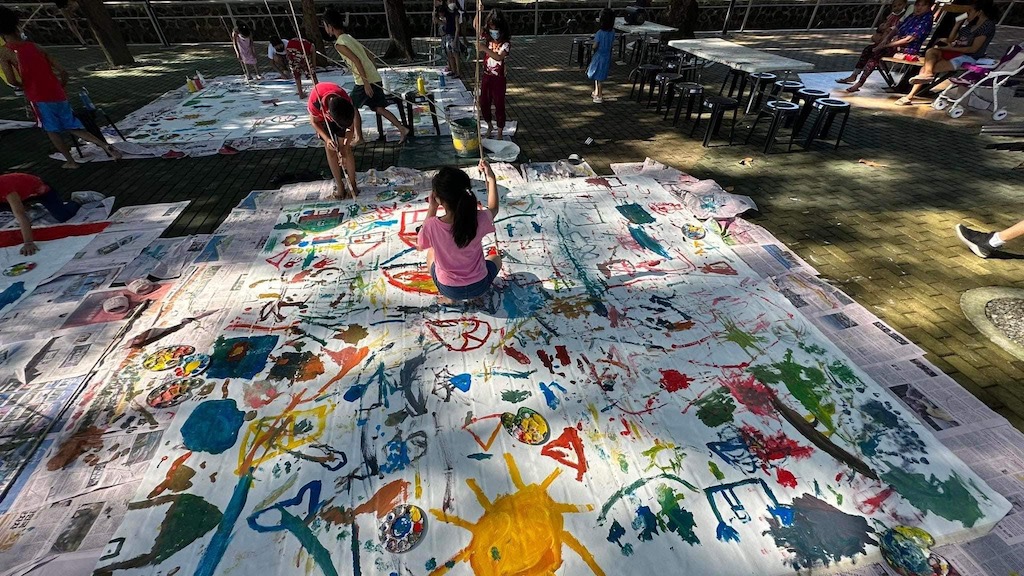
Other than the Tinipak River art initiative, Nomad Projects also has an ongoing installation project called “We Are Of,” which consists of hand-built clay multiples by children from various communities in Luzon, Visayas, and Mindanao. It is one of the alternative ways through which they encourage learning outside the formal classroom system.
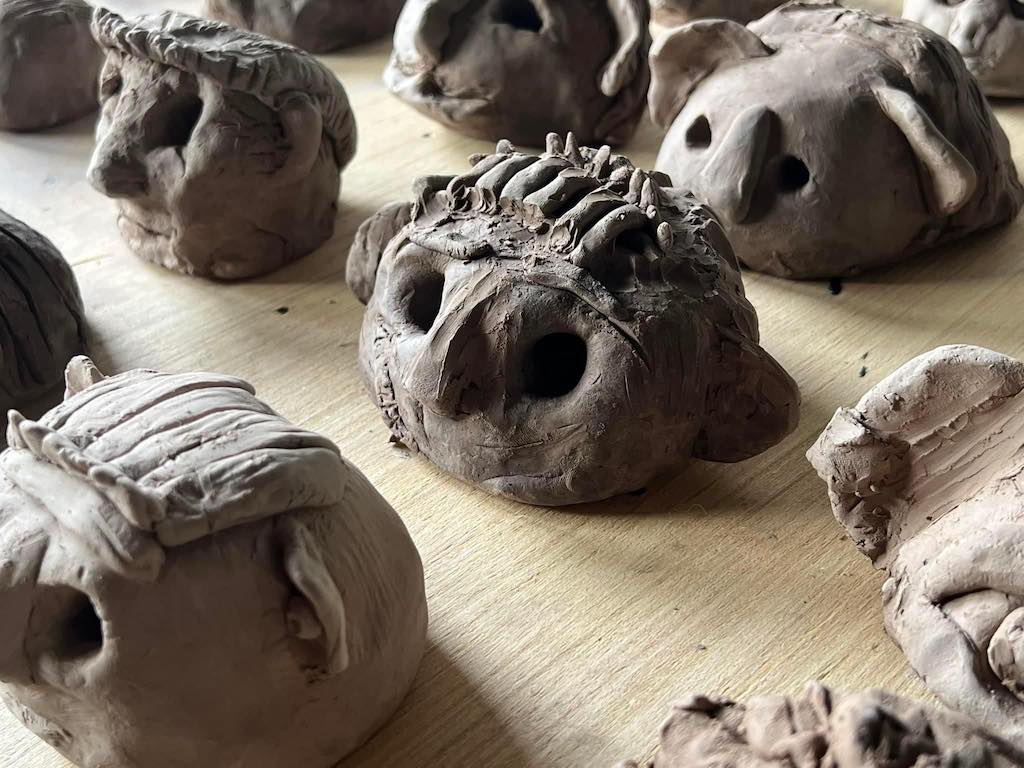
Through working with clay, children are made to ponder their unique connection to the earth. “Like a body of land that continuously evolves, this work is never permanent and fixed. It opens up space for participation and will never be finished. Expanding work siya and we hope we can get all the support ng mga local government units at mga communities in this project.”
Nomad Projects also invites volunteers to their initiatives. Just like in their race to document all rocks in Tinipak River before Kaliwa Dam drowns them, Valencia emphasizes the importance of community and creation as part of a community. “[When you] look beyond buildings and economic structures, what is left is community. To commune, it won’t require a college degree, a high-paying job, or a CV. It only requires your humanity. Everyone can be part of it. Rethink how species occupy spaces.”

